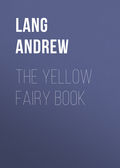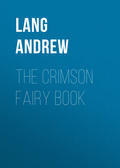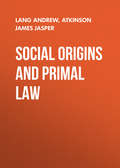
Lang Andrew
The Mystery of Mary Stuart
APPENDIX C
THE DATE OF MARY’S VISIT TO GLASGOW
The question of the possibility that Letter II. may be authentic turns on dates. If the Lords are right in declaring, in ‘Cecil’s Journal,’ that Mary left Edinburgh on January 21, 1567, and arrived in Glasgow on January 23, then the evidence of the Letter is incompatible with that of Paris, and one or both testimonies must be abandoned. They fare no better if we accept the statement of Drury, writing from Berwick, that Mary entered Glasgow on January 22. It is shown in the text that, if we accept the date as given in Birrel’s ‘Diary,’ and also in the ‘Diurnal of Occurrents’: if we make Mary leave Edinburgh on January 20, and (contrary to Drury and ‘Cecil’s Journal’) make her enter Glasgow on January 21, then the Letter may be brought into harmony with the statement of Paris.
Of course it may be argued that the ‘Diurnal’ and Birrel’s ‘Diary’ coincide in an error of date. The ‘Diary’ of Birrel describes itself as extending from 1532 to 1605. One man cannot have kept a daily note of events for seventy-three years. The ‘Diary,’ in fact, is not a daily record. There is but one entry for 1561, one for 1562, one for 1565, ten for 1566, and twenty-four for 1567; up to Mary’s surrender at Carberry (June 15). The ‘Diurnal,’ for our period, is more copious, and is by a contemporary, though probably he did not always write his remarks on the day of the occurrence noted.
From August 19, 1561, to June 15, 1567, the ‘Diurnal’ and the ‘Diary’ record in common twenty-one events, with date. In seven of these cases they differ, as to date. They differ as to the day of Mary’s departure from Edinburgh to Jedburgh, as to the departure of the ambassadors from Stirling, as to the arrival of Mary with her infant child in Edinburgh (January, 1567), as to the return of Mary and Darnley from Glasgow, as to the day of Darnley’s burial, as to the day of opening Parliament, and as to the attack on Borthwick Castle by the Lords: while the ‘Diurnal’ makes the explosion at Kirk o’ Field occur at 2 A.M. on February 10, but ends the Parliament on April 29, which is absurd. When the dates are correctly known from other sources, and when the ‘Diary’ and the ‘Diurnal’ coincide as to these dates, then, of course, we may accept their authority. But when, as in the case of Mary’s departure from Edinburgh, and arrival in Glasgow, the ‘Diary’ and ‘Diurnal’ oppose ‘Cecil’s Journal,’ and Drury’s version, every reader must estimate the value of their coincidence for himself. If their date, January 20, is correct, then a letter may have been written, and sent, and received, and the facts, so far, are corroborated by Paris’s deposition.
The argument of Chalmers, that Mary was at Edinburgh till January 24, because there are entries as if of her presence there in the Register of Privy Seal, is not valid, as such entries were occasionally made in the absence of the King or Queen.
APPENDIX D
THE BAND FOR DARNLEY’S MURDER
This Band, which is constantly cited in all the troubles from 1567 to 1586, is a most mysterious document. We have seen that Mary’s secretary, Nau, wilfully or accidentally confuses it with an anti-Darnley band signed by Morton, Moray, and many others, early in October, 1566. We have also seen that Randolph, in 1570, distinguishes between this ‘old band’ and the band for the murder, which, he says, Lethington and Balfour abstracted from a little coffer in the Castle, covered with green cloth or velvet, immediately after Mary surrendered at Carberry. I have ventured the theory that this carefully covered little coffer may have been the Casket itself.[415] Drury, again, in November, 1567, reports that the band has been burned, while the papers as to Mary are ‘kept to be shewn.’ But, in Scotland, till Morton’s execution in June, 1581, the murder band was believed to be extant: at least Sir James Balfour, if he chose, could give evidence about it. What Mary wished to be believed as to this matter, we have seen in Nau, who wrote under her inspiration between 1575 and 1587. He asserts that Bothwell, ‘to ease his conscience’ gave Mary a copy of the band, when he rode away from Carberry (June 15, 1567). He showed Mary the signatures of Morton, Balfour, Lethington, and others. She kept the document, and, when she met Morton on Carberry Hill, told him that he was one of the chief murderers, as she had learned. He slunk away.[416] Probably Mary did accuse Morton, at Carberry. When he was executed (June 3, 1581) Sir John Foster, from Alnwick, sent an account of the trial to Walsingham. In the evidence against Morton was ‘the Queen’s confession when she was taken at Carberry Hill. She said he was the principal man that was the deed-doer, and the drawer of that purpose.’ Morton certainly was not present, and it is as good as certain that he did not sign the band. Still, Mary, at Carberry, charged him with complicity.[417]
We have seen that Mary, ever after Carberry, also inculpated Lethington, and vowed that she had something in black and white which would hang him. Something she probably did possess, but not a band signed also by Morton. Concerning the murder-band, Hay of Tala, before execution (January 3, 1568), ‘in presence of the whole people,’ named as subscribers ‘Bothwell, Huntly, Argyll, Lethington, Balfour, with divers other nobles.’[418] Hay saw their signatures, but not that of Morton. ‘He said my Lord Bothwell said to him that he subscribed the same.’ The Black Laird (December 13, 1573), when in a devout and penitent condition, said that Bothwell had shown him the contract, ‘subscribed by four or five handwrites, which, he affirmed to me, was the subscription of the Earl of Huntly, Argyll, the secretary Maitland, and Sir James Balfour.’ Ormistoun repeated part of the contents: the paper was drawn up by Balfour, a Lord of Session.[419] (See Introduction, pp. xiii-xviii.)
Morton, we know, was accused of Darnley’s death, and arrested, at the end of December, 1580. Archibald Douglas was sought for, but escaped into England. Elizabeth sent Randolph down to save Morton: Hunsdon was to lead an army over the Border. Every kind of violence was designed, and forgery was attempted, but Randolph had to fly to Berwick, at the end of March. Meanwhile the arch traitor, Balfour, had been summoned from France, as an evidence against Morton. But he was not of much use. On January 30, 1581, he wrote from Edinburgh to Mary. He had arrived in Scotland on December 17, 1580, when he found Morton in the height of power. Balfour secretly approached James’s new favourite, Stewart d’Aubigny, recently created Earl of Lennox. By giving them information ‘had from your Majesty’s self, and partly by other intelligence which I knew and learned from others,’ he gave them grounds for Morton’s arrest. But Morton, he says, trusting to the lack of testimony from the absence of Archibald Douglas, boldly ‘denies all things promised by him to Bothwell in that matter,’ ‘except his signature to the band whereof I did send the copy to your Majesty.’ Now that was only ‘Ainslie’s band,’ made after the murder, on April 19, 1567, to defend Bothwell’s quarrel. On an extant copy Randolph has written, ‘upon this was grounded thacusation of therle Morton.’[420] This was no hanging matter, and Balfour either had not or would not produce the murder band. He therefore asks Mary for further information: ‘all that your Majesty has heard or known thereinto.’[421]
Balfour and Mary corresponded in cypher through Archbishop Beaton, her ambassador in France. On March 18, 1580, she had written to Beaton, ‘if possible make Balfour write to me fully about the band which he has seen, with the signatures, for the murder of my late husband, the King, or let him give you a copy in his own hand.’ If she really possessed the band which Nau says Bothwell gave her at Carberry, she needed no copy from Balfour. She does not seem to have believed in him and his band. On May 20, 1580, she writes to Beaton: ‘I put no faith in what Balfour has sent me, so far, and cannot trust him much having been so wretchedly betrayed by him,’ for Balfour had put Morton on the trail of the Casket, had sold the Castle, and later, had betrayed Kirkcaldy and Lethington when they held the Castle against Morton. However, she sent to Balfour a civil message, and bade him go on undermining Morton, in which he succeeded, in the following year. But the murder-band was never produced. On March 16, 1581, Randolph described a conference which had passed between him and James VI. ‘I spoke again of the band in the green box, containing the names of all the chief persons consenting to the King’s murder, which Sir James Balfour either hath or can tell of.’ Randolph, who was working for Morton, obviously knew that he did not sign that band: otherwise he would have avoided the subject.[422]
We have no account of Morton’s trial, save what Foster tells Walsingham. ‘The murder of the King was laid to him by four or five witnesses. The first is the Lord Bothwell’s Testament’ (usually thought to be forged), ‘the second, Mr. Archibald Douglas, when he was his man.’ But Douglas, surely, dared not appear in Court, or in Scotland. Foster clearly means that Archibald’s servant, Binning, proved his guilt, and that it reflected on Morton, whose ‘man’ Archibald was, in 1567, and later. Next came the charge that Morton ‘spoke with’ Bothwell, as he confessed that he did, at Whittingam, about January 20, 1567, when he says that he declined to join the plot without Mary’s written warrant. How could this be known, except through Mary or Archibald Douglas? Possibly his brother, at whose house the conference was held, may have declared the matter, as he ‘split,’ in 1581, on Archibald, and all concerned. ‘And then’ Morton was condemned on ‘the consenting to the murder of the King’ (how was that proved?), on Ainslie’s band to support Bothwell’s quarrel, ‘no person being excepted,’ and finally, ‘the Queen’s confession at Carberry Hill,’ when she confessed nothing, but accused Morton.
Mary’s conduct, as far as it can be construed, looks as if she knew very little either about Morton or the murder-band. If Bothwell told her anything, what he told her was probably more or less untrue.
APPENDIX E
THE TRANSLATIONS OF THE CASKET LETTERS
The casual treatment of the Casket Letters by Mary’s accusers, and by the English Commissioners, is demonstrated by an inspection of the texts as they now exist. One thing is absolutely certain, the Letters were produced, at Westminster and Hampton Court, in the original French, whether that was forged, or garbled, or authentic. This is demonstrated by the occurrence, in the English translation, of the words ‘I have taken the worms out of his nose.’ This ugly French phrase for extracting a man’s inmost thoughts is used by Mary in an authentic letter.[423] But the Scots version of the passage runs, ‘I have drawn all out of him.’ Therefore the English translator had a French original before him, not the French later published by the Huguenots, where for tiré les vers du nez, we find j’ay sçeu toutes choses de luy.
Original French letters were therefore produced; the only doubt rests on part of Crawford’s deposition, where it verbally agrees with Letter II. But we may here overlook Crawford’s part in the affair, merely reminding the reader that the French idioms in that portion of the Letter (Scots version) which most closely resembles his very words, in his deposition, may have come in through the process of translating Crawford’s Scots into French, and out of French into Scots again, to which we return.
The Casket Letters were produced, in French, on December 7 and 8. On December 9, the English Commissioners read them, ‘being duly translated into English.’[424] We are never told that the Scottish Lords prepared and produced the English translations. These must have been constructed on December 7 and 8, in a violent hurry. So great was the hurry that Letter VI. was not translated from French at all: the English was merely done, and badly done, out of the Scots. Thus, Scots, ‘I am wod;’ English, ‘I am wood.’ As far as this Letter goes, there need have been no original French text.[425] In this case (Letter VI.) the English is the Scots Anglified, word for word. The same easy mode of translating French is used in Letter V.; it is the Scots done word for word into English. In Letters I. and II., M. Philippson makes it pretty clear that the English translator had a copy of the Scots version lying by him, from which he occasionally helped himself to phrases. M. Cardauns, in Der Sturz der Maria Stuart, had proved the same point, which every one can verify. Dozens of blunders occur in the English versions, though, now and then, they keep closer to the originals than do the Scots translators.
Of this we give a singular and significant proof. In the Scots of Letter I. the first sentence ends, ‘Ze promisit to mak me advertisement of zour newis from tyme to tyme.’ The next sentence begins: ‘The waiting upon yame.’ In the English we read ‘at your departure you promised to send me newes from you. Nevertheless I can learn none:’ which is not in the Scots, but is in the published French, ‘et toutes fois je n’en puis apprendre.’ The published French is translated from the Latin, which is translated from the Scots, but each of the French published letters opens with a sentence or two from the original French: thus the published French, in one of these sentences, keeps what the Scots omits.
Therefore, the Scots translator undeniably, in the first paragraph of Letter I., omitted a clause which was in his French original, and is in the English translation. Consequently, when, in the same short letter, the English has, and the Scots has not, ‘to Ledington, to be delivered to you,’ we cannot, as most critics do, and as Herr Bresslau does, infer that Lethington had that mention of him deliberately excised from the Scots version, as likely to implicate him in the murder. It did not implicate him. Surely a Queen may write to her Secretary of State, on public affairs, even if she is planning a murder with her First Lord of the Admiralty. When the Scots translator omits a harmless clause, by inadvertence, in line 6, he may also, by inadvertence, omit another in line 41.
From these facts it follows that we cannot acquit Lethington of a possible share in the falsification of the Letters, merely because a reference to him, in the original French, existed, and was omitted in the Scots text. He need not have struck out the clause about himself, because the Scots translator, we see, actually omits another clause by sheer inadvertence. In the same way Mr. Henderson’s text of the Casket Letters exhibits omissions of important passages, by inadvertence in copying.
Again, we can found no argument on omissions or changes, in the English versions. That text omits (in Letter II.), what we find in the Scots, the word yesternight, in the clause ‘the King sent for Joachim yesternight.’ M. Philippson argues that this was an intentional omission, to hide from the English commissioners the incongruity of the dates. The translators, and probably the commissioners, did not look into things so closely. The English translators made many omissions and other errors, because they were working at top speed, and Cecil’s marginal corrections deal with very few of these blunders. On them, therefore, no theory can be based. Nor can any theory be founded on clauses present in the English, but not in the Scots, as in Letter II., Scots, ‘I answerit but rudely to the doutis yat wer in his letteris,’ to which the English text appends, ‘as though there had been a meaning to pursue him.’ This, probably, was in the French; but we must not infer that Lennox had it suppressed, in the Scots, as a reference to what he kept concealed, the rumour of Darnley’s intention to seize and crown the child prince. The real fact is that the Scots translator, as we have seen, makes inadvertent omissions.
The English text is sometimes right where the Scots is wrong. Thus, Sir James Hamilton told Mary, as she entered Glasgow, that Lennox sent the Laird of Houstoun to tell him that he (Lennox) ‘wald never have belevit that he (Sir James) wald have persewit him, nor zit accompanyit him with the Hamiltounis.’ The English has what seems better, ‘he,’ Lennox, ‘wold not have thought that he would have followed and accompany himself with the Hamiltons.’ In the end of a paragraph (3), the Scots is gibberish: Scots, ‘nevertheless he speikis gude, at the leist his son’: English (Henderson), ‘and they so speakith well of them, at least his sonne,’ ‘and then he speaketh well of them’ (Bain). The English then omits (Scots) ‘I se na uthir Gentilman bot thay of my company.’
In the next line (Scots) ‘The King send for Joachim yesternicht,’ the English omits ‘yesternicht,’ probably by inadvertence. The word has a bearing on the chronology of the Letter, and its omission in the English text may be discounted. It is a peculiarity of that text to write ‘he’ for ‘I,’ and a feature of Mary’s hand accounts for the error. Where Darnley, in the Scots, says, ‘I had rather have passit with yow,’ the sentence follows ‘I trow he belevit that I wald have send him away Presoner.’ This is not in the English, but recurs in the end of Crawford’s Deposition, ‘I thought that she was carrying him away rather as a prisoner than as a husband.’ Probably the sentence, omitted in English, was in the French: whether derived from Crawford’s Deposition or not. Presently the English gives a kind of date, not found in the Scots. Scots, ‘I am in doing of ane work heir that I hait greitly.’ The English adds, ‘but I had begun it this morning.’ Now, to all appearance, she had ‘begun it’ the night before. How did ‘but I had begun it this morning’ get into the English? For the answer see page 300. Even in the first set of Memoranda there are differences: Scots, ‘The purpois of Schir James Hamilton.’ English, ‘The talk of Sir James Hamilton of the ambassador.’
There are other mistranslations, and English omissions: the English especially omits the mysterious second set of notes. What appears most distinctly, from this comparison, is the hasty and slovenly manner of the whole inquiry. The English translators had some excuse for their bad work; the Scots had none for their omissions and misrenderings.
Letter III. (or VIII.) and Letter IV. I have translated, in the body of this book, from the copies of the French originals.
In Letter V. the copy of the French original enables us to clear up the sense. It is a question about a maid or lady in waiting, whom Bothwell, or somebody else, wishes Mary to dismiss. The French is, ‘et si vous ne me mondes [mandez] ce soir ce que volles que j’en fasse, Je mendeferay [m’en deferay] au hazard de la fayre entreprandre ce qui pourroit nuire à ce à quoy nous tandons tous deus.’ The Scots has ‘I will red myself of it, and cause it to be interprysit and takin in hand, quhilk micht be hurtful to that quhair unto we baith do tend.’ The English is the Scots, Anglified.
The real sense, of course, is ‘if you do not let me know to-night what step you want me to take, I shall get rid of her, at the risk of making her attempt something which might harm our project.’ We have no other known contemporary English translations. Of the four known, two (I. II.) are made with a frequent glance at the Scots, two are merely the Scots done into English, without any reference to the French. Nothing but the hasty careless manner of the whole inquiry accounts for these circumstances.
The most curious point connected with the translations is Crawford’s deposition. It was handed in on December 9, 1568. Whoever did it out of Crawford’s Scots into English had obviously both the Scots and English versions of Letter II. before him. Where the deposition is practically identical with the corresponding passages of Letter II., the transcriber of it into English usually followed the Scots version of Letter II. But there is a corrected draft in the Lennox MSS. at Cambridge, which proves that the Angliciser of Crawford’s Scots occasionally altered it into harmony with the English version of Letter II. Thus, in the first paragraph, the original draft of Crawford in English has, like the Scots version of Letter II., ‘the rude words that I had spoken to Cunningham.’ But, in the official copy, in English, of Crawford, and in the Lennox draft of it, ‘rude’ is changed into ‘sharpe wordes,’ and so on. The part of Crawford which corresponds with Letter II. is free from obvious literal renderings of the French idiom, as Mr. Henderson remarks.[426] These abound in the English version of the corresponding part of Letter II., but are absent here in the Scots translation. It is, therefore, open to argument that Crawford did make notes of Darnley’s and Mary’s talk; that these were done into ‘the original French,’ and thence retranslated into the Scots (free from French idiom here) and into the English, where traces of French idiom in this passage are frequent.






